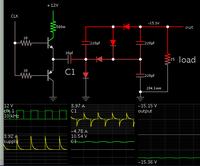bnevins
Member level 1
I want to go from +5V or +12V to +/-15V at 200mA. The noise/ripple
must be very low because it is a supply for a low noise amp.
The LT1533 has a nice demo board, but the push-pull transformer cannot be found and the Iout is a little low.,
https://www.linear.com/solutions/2506
I could use a module, but I cannot find one with comparable low noise/emi/ripple.
The solution need not be push-pull, but I do not know what else to use.
must be very low because it is a supply for a low noise amp.
The LT1533 has a nice demo board, but the push-pull transformer cannot be found and the Iout is a little low.,
https://www.linear.com/solutions/2506
I could use a module, but I cannot find one with comparable low noise/emi/ripple.
The solution need not be push-pull, but I do not know what else to use.
